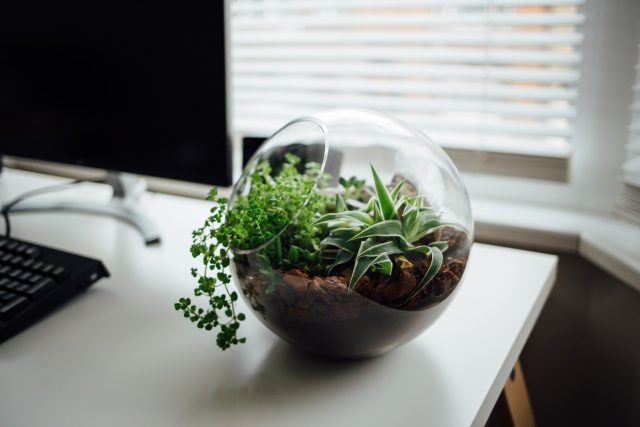Terrariums have become increasingly popular in recent years, and it’s easy to see why. These miniature gardens provide a stunning visual display while requiring minimal maintenance. Terrariums are essentially small, enclosed ecosystems with all the necessary plant growth ingredients in a glass container. Not only do they provide a beautiful addition to your home decor, but they also make perfect gifts for friends and family. Building a terrarium can be a fun and rewarding experience for plant enthusiasts of all levels, from beginners to seasoned gardeners. This blog will explore the basics of terrarium building, including the necessary materials, plant selection, and care tips to help you create your own miniature garden.
What is a Terrarium?
A terrarium is a miniature garden typically enclosed in a glass container. It is a self-contained ecosystem that can sustain plant life without requiring frequent watering or other maintenance. Terrariums are becoming increasingly popular as a way to bring a little bit of nature into your home or office.
The concept of a terrarium has been around since the mid-1800s when they were first created as a way to study and observe plant growth. Today, terrariums are commonly used as decorative pieces that add a touch of greenery to any indoor space.
Terrariums come in various shapes and sizes, from small desktop versions to large, elaborate designs. The container can be made of glass, plastic, or any other transparent material that allows for easy viewing of the plants inside.
Creating a terrarium requires careful consideration of plant selection, soil type, and container size. The plants used in a terrarium should be small and able to tolerate low-light conditions. Common terrarium choices include mosses, ferns, succulents, and air plants.
Overall, a terrarium is a beautiful and low-maintenance way to bring a little bit of nature into your home. With the right materials and care, you can create a stunning miniature garden that will provide enjoyment for years to come.
Supplies Needed
Creating a terrarium is a fun and rewarding project that requires just a few basic supplies. Here are the essential materials you will need to get started:
- Container: The first thing you’ll need is a container to house your plants. Glass containers are a popular choice, as they allow for easy viewing of your terrarium’s contents. However, you can use any clear container that is large enough to accommodate your plants.
- Soil: The soil type you use will depend on the plants you choose for your terrarium. Most plants require well-draining soil that is rich in nutrients. You can find soil mixes specifically designed for terrariums at most garden centers.
- Plants: Choose plants that are small enough to fit in your container and can tolerate low-light conditions. Popular terrarium choices include mosses, ferns, succulents, and air plants.
- Gravel or Rocks: Adding a layer of gravel or rocks to the bottom of your container will help with drainage and prevent water from collecting at the bottom.
- Activated Charcoal: Adding a layer of activated charcoal on top of the rocks will help absorb any odors and prevent mold and bacteria from growing in your terrarium.
- Decorative Elements: Adding decorative elements such as stones, shells, or miniature figurines can enhance the visual appeal of your terrarium.
Once you have gathered all the necessary supplies, you can begin building your terrarium. With a little bit of creativity and patience, you can create a beautiful miniature garden that will provide enjoyment for years to come.
Step 1: Add Soil and Stones
Building a terrarium is a fun and easy project that can be completed in just a few simple steps. Here is a guide to help you get started with the first step of creating your terrarium:
- Start by adding a layer of stones or gravel to the bottom of your container. This layer will help with drainage and prevent water from collecting at the bottom of your terrarium.
- Add a layer of activated charcoal on top of the stones. This layer will help absorb any odors and prevent mold and bacteria from growing in your terrarium.
- Add a layer of potting soil on top of the activated charcoal. The amount of soil you need will depend on the size of your container and the size of your plants.
- Use your hands or a small trowel to shape the soil to create different levels and slopes. This will give your terrarium depth and create a more natural look.
- Make sure the soil is level and smooth before adding your plants. You may also want to moisten the soil slightly before planting to help your plants establish roots.
By following these simple steps, you can create a solid foundation for your terrarium and prepare it for the next step of adding plants. Keep in mind that the type of soil and stones you use may vary depending on the plants you choose for your terrarium.
Step 2: Plant Selection and Placement
Building a terrarium is a fun and easy project that can be completed in just a few simple steps. Here is a guide to help you get started with the second step of creating your terrarium:
- Choose plants that are small enough to fit in your container and can tolerate low-light conditions. Popular terrarium choices include mosses, ferns, succulents, and air plants. Consider your plants’ size, color, and texture when selecting them.
- Arrange your plants on top of the soil in the container before planting them. Play around with different arrangements until you find a design that you like. Remember that the plants will grow over time, so leave enough space between them to allow for growth.
- Once you have decided on the placement of your plants, remove them from their pots and gently loosen the roots. Place the plants in the soil and gently press down around the base of each plant to secure it in place.
- If you use multiple types of plants in your terrarium, consider arranging them in layers or clusters to create a more natural look.
- Use a small brush or your fingers to remove any excess soil or debris from the leaves of your plants. This will help them thrive and look their best.
- Once you have planted all of your plants, add any decorative elements you may have chosen, such as stones, shells, or miniature figurines.
Remember to choose well-suited plants for a terrarium’s low-light conditions and arrange them visually pleasingly. With a little bit of creativity and patience, you can create a stunning miniature garden that will provide enjoyment for years to come.
Step 3: Watering and Maintenance
Building a terrarium is a fun and easy project that can be completed in just a few simple steps. Here is a guide to help you get started with the third step of creating your terrarium:
- Water your terrarium sparingly. Overwatering is a common mistake when it comes to terrariums. Water only when the soil feels dry to the touch. Use a spray bottle to mist the soil and plants lightly. Be careful not to overwater, as this can cause root rot and other issues.
- Keep your terrarium in a location that receives indirect sunlight. Too much direct sunlight can cause the temperature inside the terrarium to rise, which can harm your plants. Conversely, too little light can prevent your plants from growing and thriving.
- Keep an eye on your plants and remove any dead or yellowing leaves. This will help keep your terrarium looking neat and tidy.
- Clean the inside of your container regularly to prevent the buildup of dirt and debris. You can use a damp cloth or soft-bristled brush to gently clean your container’s inside.
- If your plants outgrow your terrarium, you may need to trim, remove, or replant them in a larger container.
By following these simple steps, you can keep your terrarium looking beautiful and healthy for years to come. Remember to water your terrarium sparingly, keep it in a location with indirect sunlight, and clean it regularly. With a little bit of maintenance, you can enjoy your terrarium for years to come.
Special Considerations
Building a terrarium is a fun and easy project that can be completed in just a few simple steps. However, there are a few special considerations to keep in mind to ensure the success of your terrarium:
- Choosing the right container: When selecting a container for your terrarium, it’s important to choose one that has a lid or can be covered to create a sealed environment. This will help maintain the moisture levels inside your terrarium and create a stable environment for your plants.
- Choosing the right plants: Not all plants are well-suited for terrariums. When selecting plants, look for those that can thrive in low-light and high-humidity environments. For example, succulents are not good for terrariums because they prefer dry conditions.
- Avoiding overcrowding: When planting your terrarium, be careful not to overcrowd your plants. Overcrowding can lead to resource competition and make it difficult for your plants to thrive.
- Avoiding overwatering: Overwatering is a common mistake when it comes to terrariums. To avoid overwatering, water sparingly and only when the soil feels dry to the touch.
- Choosing the right soil: The type of soil you use can have a big impact on the success of your terrarium. Choose soil that is well-draining and has good moisture retention.
By considering these special considerations, you can create a beautiful and healthy terrarium that will thrive for years to come. Remember to choose the right container, plants, and soil, and avoid overcrowding and overwatering. With a little care and attention, you can enjoy a stunning miniature garden in your home or office.
Conclusion
In conclusion, building a terrarium is a fun and rewarding project that can bring some nature into your home or office. By following a few simple steps and considering some special considerations, you can create a beautiful and healthy miniature garden that will thrive for years to come. Remember to choose the right container, plants, soil, and water and properly maintain your terrarium. With a little bit of creativity and care, you can enjoy the beauty of a miniature garden in any space. So, get started on your own terrarium project today and discover the joy of creating your own mini ecosystem.






























